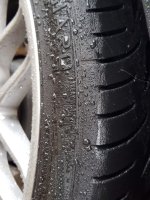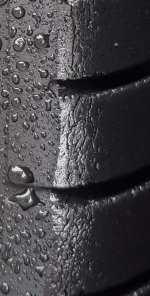You are using an out of date browser. It may not display this or other websites correctly.
You should upgrade or use an alternative browser.
You should upgrade or use an alternative browser.
MOT: Cracking around edge of tyres
- Thread starter Probocop
- Start date
I reckon you'll be fine with an MOT - depending on the place it might not even be an advisory!
though that said, how old are the tyres? they'll have a week and year date stamp on them somewhere. if they're older than 5 years I'd look to get them replaced.
though that said, how old are the tyres? they'll have a week and year date stamp on them somewhere. if they're older than 5 years I'd look to get them replaced.
As others have said it will probably be an advisory providing there aren't any lumps or bumps but personally i would throw them out!
If the MOT station does fail you then they will be doing you a favour in forcing your hand to be safe.
Are they Vredesteins? I had them on a Disco3 and they deteriorated in the same way - The outside edges of the front tyres also started to wear- the geometry was perfect but it seems the unusual wear pattern was also due to that same deterioration/breakdown of the rubber composition.
If the MOT station does fail you then they will be doing you a favour in forcing your hand to be safe.
Are they Vredesteins? I had them on a Disco3 and they deteriorated in the same way - The outside edges of the front tyres also started to wear- the geometry was perfect but it seems the unusual wear pattern was also due to that same deterioration/breakdown of the rubber composition.
And I thought you were a jeans and T shirt bear.Smartbear said:Hi, as far as i know it’s only a failure if the cords are showing :?
Rob
Do you know if the mot can he failed on tyre age...checked my tyres on my Westfield and the Avon CR500's were manufactured in 2003 
Thanks for all the replies. It's booked in for an MOT on the current tyres, but I'll get them replaced soon 
Yup, they are indeed both Vredestein. I'll likely go Michelin next time.
ronk said:Are they Vredesteins? I had them on a Disco3 and they deteriorated in the same way - The outside edges of the front tyres also started to wear- the geometry was perfect but it seems the unusual wear pattern was also due to that same deterioration/breakdown of the rubber composition.
Yup, they are indeed both Vredestein. I'll likely go Michelin next time.
From the gov site,
2.12 Tyres and wheels
These will be inspected to check for:
condition
security
tyre size and type
tread depth
Spare wheels and tyres are not inspected.
Vehicles first used on or after 1 January 2012 will be checked to make sure the tyre pressure monitoring system (TPMS) MIL is working.
2.12 Tyres and wheels
These will be inspected to check for:
condition
security
tyre size and type
tread depth
Spare wheels and tyres are not inspected.
Vehicles first used on or after 1 January 2012 will be checked to make sure the tyre pressure monitoring system (TPMS) MIL is working.
Most manufacturers' recommended maximum is 6 years, not 16. :rofl:Leesfarm07 said:Do you know if the mot can he failed on tyre age...checked my tyres on my Westfield and the Avon CR500's were manufactured in 2003
Busterboo said:Most manufacturers' recommended maximum is 6 years, not 16. :rofl:Leesfarm07 said:Do you know if the mot can he failed on tyre age...checked my tyres on my Westfield and the Avon CR500's were manufactured in 2003
I don’t think they would fail it for that, the inspection is based on condition not age
Rob
True, Rob.Smartbear said:Busterboo said:Most manufacturers' recommended maximum is 6 years, not 16. :rofl:Leesfarm07 said:Do you know if the mot can he failed on tyre age...checked my tyres on my Westfield and the Avon CR500's were manufactured in 2003
I don’t think they would fail it for that, the inspection is based on condition not age
Rob
For what it's worth, though, my experience of old tyres is that they not only decay at the edges, but also crack between the treads. So, you're driving round on rubber compound that, when it fails, fails 'catastrophically'.
Put another way, who'd want to risk their lives on crappy old tyres anyway?
Busterboo said:True, Rob.Smartbear said:Busterboo said:Most manufacturers' recommended maximum is 6 years, not 16. :rofl:
I don’t think they would fail it for that, the inspection is based on condition not age
Rob
For what it's worth, though, my experience of old tyres is that they not only decay at the edges, but also crack between the treads. So, you're driving round on rubber compound that, when it fails, fails 'catastrophically'.
Put another way, who'd want to risk their lives on crappy old tyres anyway?
I remember when poor/mean drivers used to fit remould tyres which were old tyres with a new treaded part glued on, thankfully i don’t think they’re available anymore!
Rob
Definitely still available...Kingpin, Technic, Virager, etc. but you might as well buy mid-range new tyres instead for cars.Smartbear said:I remember when poor/mean drivers used to fit remould tyres which were old tyres with a new treaded part glued on, thankfully i don’t think they’re available anymore!
Watching Harry's Garage on Youtube and they were talking with Longstone Tyres , as he was getting new rubber for the Countach and they lifed tyres for 6 years , before the rubber dries and you loose traction, grip and general reliability from the tyres. So, I suspect those tyres are beyond their best days , but check the date stamp on them. Also using tyre dressings does protect against UV , so worth considering on some of our cars that dont do huge mileages.
The main causes of tyre cracking are attack by ozone from the atmosphere, lack of use and strain and overheating, particularly from under inflation and UV as mentioned. Tyre compounds contain carbon black (C) which is basically incompletely burnt oil soot. The C molecules are added to stabilise the rubber, transfer heat and reduce rolling resistance and is what makes tyres black. When a tyre is used the molecules in the compound are agitated maintaining the chemical bonds helping to resist cracking. When tyres are not used for a while Ozone attacks the surface of the tyre loosening the molecular bonds in the material, but cracks will not form until the tyre is subjected to stress and strain. So an old tyre that hasn't been used for a while can look fine but will suddenly develop cracks when used again. The cracks develop at the surface where the Ozone has been at work but are not actually a safety issue unless the ply is exposed or the tread is in danger of separating, which is a biggie on our cars and would be the main concern.
I had a perfect example of this when I bought a 14 month old car that had been driven for 300 miles and garaged. The tyres were obviously as new, but within a few months started cracking horribly and had to be changed. This is why buying old tyre stock may be a false economy and I always ask for tyre dates when buying.
In a previous life I helped design parts of the old Sevalco carbon black plant near Bristol which supplied C to many makers around Europe. Different makers are now using various additives and formulations of C to improve performance and some will resist cracking better than others, but there is little you can do to prevent cracking other than using the tyre and keeping it properly inflated. Six years is the industry standard for tyre life although I've had tyres way older than that that have been fine, I've also had tyres with micro surface cracks that never got much worse and were used until worn out.
Interestingly solvents, detergents and other chemicals found in some 'detailing' products may actually degrade the chemical composition of the tyre surface, you would need to check out the exact formulations and do a bit of research but my guess is a lot of them will make tyres look nice but do more harm than good in the long run. I open the floor for informed debate on that one...... :fuelfire:
I had a perfect example of this when I bought a 14 month old car that had been driven for 300 miles and garaged. The tyres were obviously as new, but within a few months started cracking horribly and had to be changed. This is why buying old tyre stock may be a false economy and I always ask for tyre dates when buying.
In a previous life I helped design parts of the old Sevalco carbon black plant near Bristol which supplied C to many makers around Europe. Different makers are now using various additives and formulations of C to improve performance and some will resist cracking better than others, but there is little you can do to prevent cracking other than using the tyre and keeping it properly inflated. Six years is the industry standard for tyre life although I've had tyres way older than that that have been fine, I've also had tyres with micro surface cracks that never got much worse and were used until worn out.
Interestingly solvents, detergents and other chemicals found in some 'detailing' products may actually degrade the chemical composition of the tyre surface, you would need to check out the exact formulations and do a bit of research but my guess is a lot of them will make tyres look nice but do more harm than good in the long run. I open the floor for informed debate on that one...... :fuelfire:
Similar threads
- Replies
- 5
- Views
- 88
- Replies
- 0
- Views
- 54

